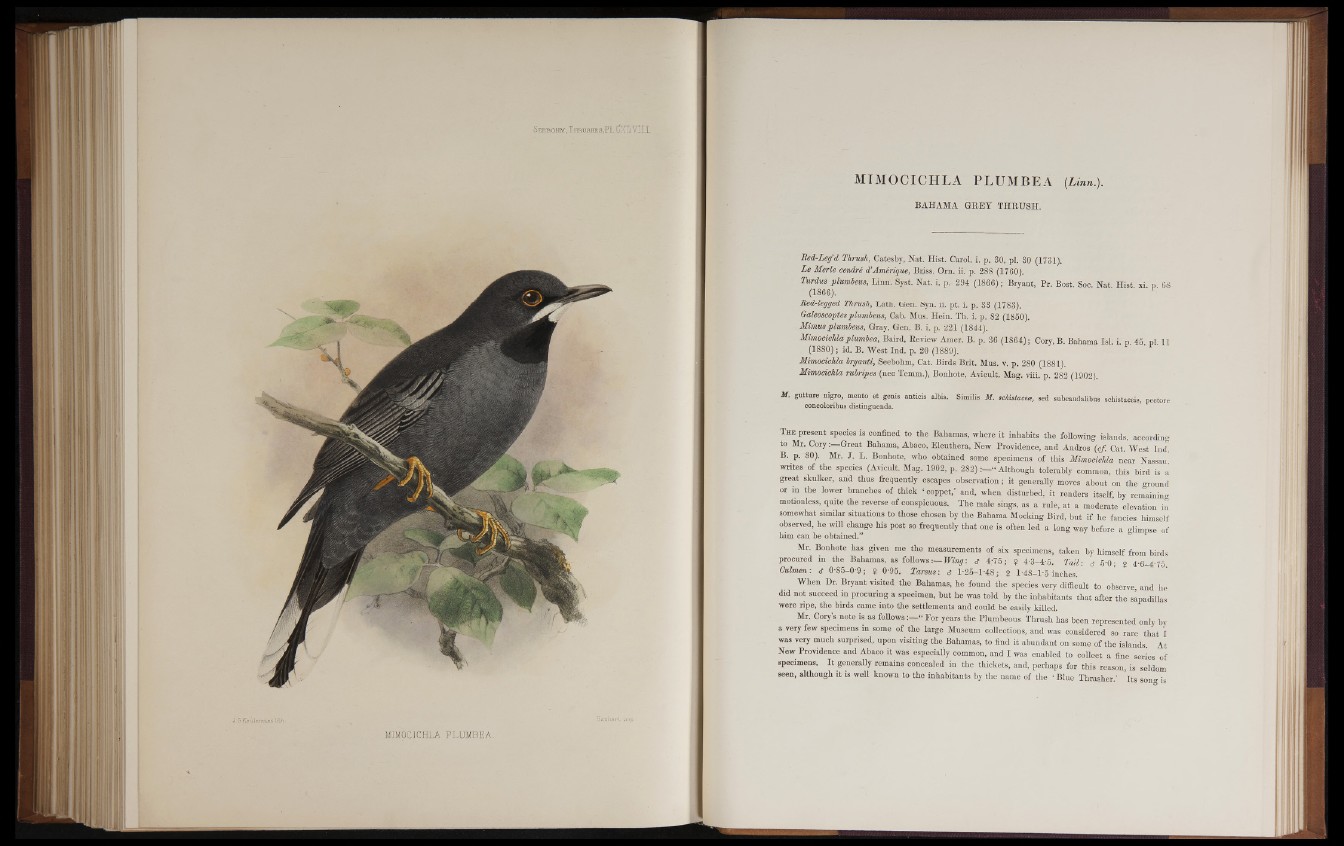
J. G. Keu.lema.ti6 libVi.
MIMOCICHLA P LUM B EA
MIMOC ICHLA P L UM B E A (Linn.).
BAHAMA GREY THRUSH.
Red-Leg’d Thrush, Catesby, Nat. Hist. Carol, i. p. 30. pi. 30 (1731).
Le Merle cendré d’Amérique, Brfss. Orn. ii. p. 288 (1760).
Turdus plumb eus, Linn. Syst. Nat. i. p.- 294 (1866) ; Bryant. Pr. Bost. Soc. Nat. Hist xi. p 68
(1866). .
Red-legged Thrush, Lath. Gen. Syn. ii. pt. i. p. 33 (1783).
Galeoscoptes plumheus, Cab. Mus. Hein. Th. i. p, 82 (1850).
Mimusplumheus, Gray, Gen. B. i. p. 221 (1844).
Mimocichlaplúmbea, Baird, Review Amer. B. p. 36 (1864); Cory.B. Bahama Isl. i. p. 45, pi. 11
(1880) ; id. B. West Ind. p. 20 (1889).
Mimocichla hryanti, Seebohm, Cat. Birds Brit. Mus. v. p. 280 (1881).
Mimociehla ruhripes (nec Temm.), Bonhote, Avicult. Mag. viii. p. 282 (1902).
M. gutture nigro, mentó et genis nnticis albis. Similis M. schMace*, sed subcaudalibus schistaceis, pectore
concoloribus distinguenda.
T he present species is confined to the Bahamas, where it inhabits the following islands, according,
to Mr. Cory: Great Bahama, Ahaco, Eleuthera, New Providence, and Andros (cf. Cat. West Ind.
B. p. 80). Mr. J. L. Bonhote, who obtained some specimens of this Mimocichla near Nassau
writes of the species (Avicult. Mag. 1902, p. 282) ¡—“ Although tolerably common, this bird is a
great skulker, and thus frequently escapes observation; it generally moves about on the ground
or in the lower branches of thick ‘ coppet,’ and, when disturbed, it renders itself, by remaining
motionless, quite the reverse of conspicuous. The male sings, as a rule, at a moderate elevation in
somewhat similar situations to those chosen by the Bahama Mocking Bird, but if he fancies him«clf
observed, he will change his post so frequently that one is often led a long way before a »limpse of
him can be obtained.” °
Mr. Bonhote has given me the measurements of six specimens, taken by himself from birds
procured in the Bahamas, as follows -.— Wing-. <j 4-75; S 4-3-4-5. Tail: s 5-0; s 4-6-4-75
Culmen: t 0-85-0-9; $ 0-95. Tarsus: a 1-25-1-48; s 1-48-1-5 inches.
When Dr. Bryant visited the Bahamas, he found the species very difficult to observe and he
did not succeed in procuring a specimen, but he was told by the inhabitants that after the simadillas
were ripe, the birds came into the settlements and could be easily killed.
Mr. Cory’s note is as follows:—'“ For years the Plumbeous Thrush has been represented only by
a very few specimens in some of the large Museum collections, and was considered so rare that I
was very much surprised, upon visiting the Bahamas, to find it abundant on some of the islands At
New Providence and Abaco it was especially common, and I was enabled to collect a fine series of
specimens. I t generally remains concealed in the thickets, and, perhaps for this reason, is seldom
seen, although it is well known to the inhabitants by the name of the ‘ Blue Thrasher.’ Its son» is